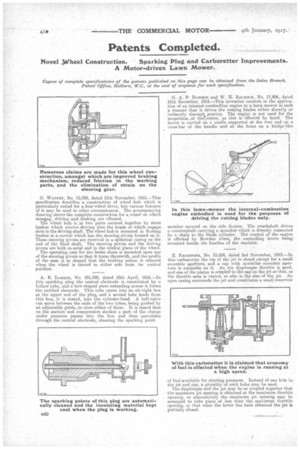Patents Completed.
Page 20

If you've noticed an error in this article please click here to report it so we can fix it.
Novel Nheel Construction. Sparking Plug and Carburetter Improvements. A Motor-driven Lawn Mower.
Copies of complete specifications of the patents published on this page can be obtained from the Sales Branch, Patent Office, Holborn, W.C., at the cost of sixpence for each specification.
G. Wamtv, No. 15,980, dated 12th November, 1915.—This specification describes a construction of wheel hub which is particularly suited for a four-wheel drive, but various features of it may be used in other circumstances. The accompanying drawing shows the complete construction for a wheel on which steeling, driving and braking are effected. The wheel hub is, in two parts secured together by stout bushes which receive driving pins the heads of which engage slots in the driving shaft.. The wheel hub is mounted in floating bushes in a carrier which has the steering pivots formed on These steering pivots are received in a spherical casing on the end of the fixed shaft. The steering pivots and the driving pivots are both co-axial and in the central plane of the wheel. The operating cam for the brake shoes is mounted upon one of the steering pivots so that it turns therewith, and the profile of the cam is so shaped that the braking action is reduced when the wheel is turned to either side from its central position.
A. E. Laatimr, No. 101,592, dated 10th April, 1916.—In this sparking plug the central electrode is constituted by a hollow tube, and a bow-shaped piece extending across it forms the earthed electrode. This tube opens into an air-tight box at the upper end of the plug, and a second tube leads from this .13ex, it is stated, into the cylinder-head. A ball-valve can move between the ends of the two tubes, being guided by an adjustable guide, to close either of them. It is stated that en the suction and compression strokes a part of the charge under pressure passes into the box and then percolates through the central electrode, cleaning the sparking point.
G. A. P. DawsoN and W. H. Bar.noca, No. 17,406, dated 13th December, 1915.—This invention consists in the application of an internal-combustion engine to a lawn mower in such a manner that it drives the cutting blades either directly or indirectly through gearing. The engine is not used for the propulsion .of thercutter, as this is effected by hand. The motor is carried on a cradle supported at the rear end on a cross-bar of the handle and at the front on a bridge-like
member secured on the side frames. The crankshaft drives a countershaft carrying a sprocket which is directly connected by a chain to the blade cylinder. The control of the engine is effected by Bowden wires., the controlling levers being f mounted beside the handles o the machine.
E. EXCOFFEER, No. 15,524, dated 3rd November, 1915.—In this carburetter the top of the jet is closed except for a mall eccentric aperture, and a cap with a4similar eccentric aperture is rotatable on it. An iris diaphragm throttle is used, and one of the plates is coupled to the cap on the jet so that, as the throttle area is varied, so also is the size of the jet. An open casing surrounds the jet and constitutes a small reservoir of fuel available for starting purposes. Instead of one hole in the jet and cap, a plurality of such holes may be used. The diaphragm and the jet may be so coupled together that the maximum jet opening is obtained at the maximum throttle opening, or alternatively the maximum jet opening may be arranged to take place at less than the maximum throttle opening, so that when the latter has been obtained the jet is partially closed.




















